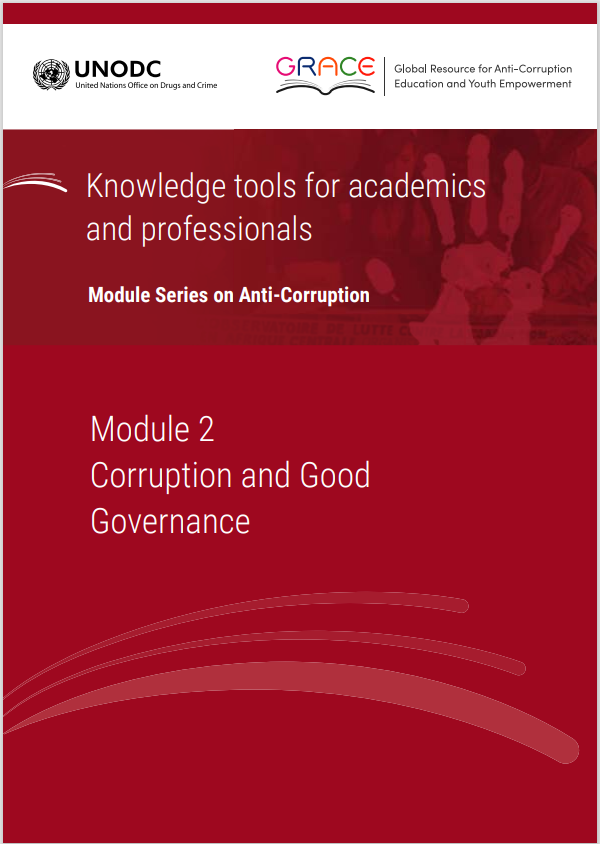This module is a resource for lecturers
References
- Andrews, Matt (2008). The Good Governance Agenda: Beyond Indicators without Theory. Oxford Development Studies, vol. 36, issue 4 (December), pp. 379-407.
- De Silva, Amala (n.d.). A Framework for Measuring Responsiveness. GPE Discussion Paper Series, no. 32. World Health Organization.
- Fukuyama, Francis (2013). What is Governance? Governance, vol. 26, issue 03 (July), pp. 347-368. Wiley Periodicals, Inc.
- Ghosh, R.N., and Mohammed Abu Bakar Siddique (2015). Corruption, Good Governance and Economic Development: Contemporary Analysis and Case Studies. World Scientific Publishing.
- Gilley, Bruce (2006). The Determinants of State Legitimacy: Results from 72 Countries. International Political Science Review, vol. 27, no. 1 (January), pp. 47-71.
- Grindle, Merilee S. (2007). Good enough governance revisited. Development Policy Review, vol. 25, issue 05 (September), pp. 553-574.
- Grindle, Merilee S. (2017). Good Governance, R.I.P.: A Critique and an Alternative. Governance, vol. 30, issue 01 (January), pp. 17-22.
- Helliwell, John F., and others (2018). Empirical linkages between good governance and national well-being. Journal of Comparative Economics, vol. 46, issue 04 (December), pp. 1332-1346.
- Holland, Jeremy, and others (2009). Measuring Change and Results in Voice and Accountability Work. Department for International Development Working Paper Series. Paris: Organisation for Economic Cooperation and Development.
- Holmberg, Sören, and Bo Rothstein (2011). Dying of corruption. Health Economics, Policy and Law, vol. 6, issue 04 (September), pp. 529-547.
- Holmberg, Sören, Bo Rothstein, and Naghmeh Nasiritousi (2009). Quality of Government. What you get. Annual Review of Political Science, vol. 12 (June), pp. 135-161.
- Hooghe, Marc, and Ellen Quintelier (2014). Political participation in European countries: The effect of authoritarian rule, corruption, lack of governance and economic downturn. Comparative European Politics, vol. 12, issue 02 (March), pp. 209-232.
- Ivanyna, Maksym, and Anwar Shah (2018). Ranking Countries for Good Governance Using Public Opinion Surveys. In The Palgrave Handbook of Indicators in Global Governance, Malito, Debora V. and others, eds. Palgrave Macmillan.
- Johnston, Michael (2002). Good Governance: Rule of Law, Transparency, and Accountability.
- Kaufmann, Daniel, Aart Kraay, and Pablo Zoido-Lobatón (1999). Aggregating Governance Indicators. Policy Research Working Paper. Washington, DC: The World Bank Development Research Group.
- Keefer, Philip (2004). A Review of the Political Economy of Governance: From Property Rights to Voice. World Bank Policy Research Working Paper. Washington, DC: The World Bank Development Research Group.
- Kostadinova, Tatiana (2009). Abstain or Rebel: Corruption Perceptions and Voting in East European Elections. Politics & Policy, vol. 37, issue 04 (August), pp. 691-714.
- Lapuente, Victor, and Bo Rothstein (2010). Civil War Spain versus Swedish Harmony. Prepared for the 2010 Annual Meeting of the American Political Science Association, Washington DC.
- Linares, Alejandro (2016). Access and citizen participation. An update of indicators for the democratization of communications . Intercom, Rev. Bras. Ciênc. Comun, vol. 39, issue 03 (December), pp. 37-52.
- Moore, Mick (1993). Declining to Learn From the East? The World Bank on Governance and Development. IDS Bulletin, vol. 24, issue 01 (January), pp. 39-50.
- Mungiu-Pippidi, Alina (2015). Corruption: Good Governance powers innovation. Nature, vol. 518, issue 7539 (February), pp. 295-297.
- Mungiu-Pippidi, Alina, and others (2017). Index of Public Integrity , European Research Centre for Anti-Corruption and State-Building (ERCAS).
- North, Douglass, John Wallis, and Barry Weingast (2009). Violence and Social Orders: A Conceputal Framweork for Interpreting Recorded Human History. New York: Cambridge University Press.
- Olken, Benjamin A., and Rohini Pande (2012). Corruption in Developing Countries. Annual Review of Economics, vol. 4 (April), pp. 479-509.
- Ott, Jan (2010). Greater Happiness for a Greater Number: Some Non-controversial Options for Governments. Journal of Happiness Studies, vol. 11, Issue 05 (May), pp. 631-647.
- Råby, Nils, and Jan Teorell (2010). A Quality of Government Peace? Bringing the State Back Into the Study of Inter-State Armed Conflict. Prepared for delivery at the 2010 Annual Meeting of the American Political Science Association, Washington DC.
- Rawls, John (1971). A Theory of Justice. Harvard University Press.
- Rose, Richard, and Caryn Peiffer (2019). Bad Governance and Corruption. Political Corruption and Governance Book Series. Springer Nature.
- Rose-Ackerman, Susan (2016). What Does "Governance" Mean? Governance, vol. 30, issue 01 (May), pp. 23-27.
- Rothstein, Bo, and Jan Teorell (2008). What is Quality of Government? A Theory of Impartial Government Institutions. Governance, vol. 21, issue 2 (April), pp. 165-190.
- Rothstein, Bo, and Aiysha Varraich (2017). Making Sense of Corruption. New York: Cambridge University Press.
- Swaroop, Vinaya, and Andrew Sunil Rajkumar (2002). Public Spending and Outcomes: Does Governance Matter? Policy Research Working Paper, issue 2840 (May). Washington, DC: World Bank Development Research Group.
- United Nations (2004). Report of the Secretary-General: The Rule of Law and Transitional Justice in Conflict and Post-Conflict Societies (S/2004/616).
- United Nations (2016). Integrated Technical Guidance Notes on Transnational Organized Crime and Security Sector Reform . United Nations SSR Task Force.
- United Nations Economic and Social Commission for Asia and the Pacific (UNESCAP) (2009). What is Good Governance? , Bangkok.
- Williams, Andrew (2014). A Global Index of Information and Political Transparency . The University of Western Australia.
 Next:
Exercises
Next:
Exercises
 Back to top
Back to top
